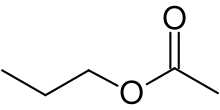Propyl group

In organic chemistry, a propyl group is a three-carbon alkyl substituent with chemical formula −CH2CH2CH3 for the linear form. This substituent form is obtained by removing one hydrogen atom attached to the terminal carbon of propane.[1] A propyl substituent is often represented in organic chemistry with the symbol Pr (not to be confused with the element praseodymium).
An isomeric form of propyl is obtained by moving the point of attachment from a terminal carbon atom to the central carbon atom, named isopropyl or 1-methylethyl. To maintain four substituents on each carbon atom, one hydrogen atom has to be moved from the middle carbon atom to the carbon atom which served as attachment point in the n-propyl variant, written as −CH(CH3)2.[2]
Linear propyl is sometimes termed normal and hence written with a prefix n- (i.e., n-propyl), as the absence of the prefix n- does not indicate which attachment point is chosen, i.e. absence of prefix does not automatically exclude the possibility of it being the branched version (i.e. i-propyl[citation needed] or isopropyl).[1][failed verification] In addition, there is a third, cyclic, form called cyclopropyl, or c-propyl[citation needed]. It is not isomeric with the other two forms, having a different chemical formula (−C3H5 vs −C3H7), not just a different connectivity of the atoms.
Examples
[edit]n-Propyl acetate is an ester which has the n-propyl group attached to the oxygen atom of the acetate group.

Other examples
[edit]References
[edit]- ^ a b "IUPAC Nomenclature - Acyclic Hydrocarbons Rule A-1". Retrieved 2022-07-31.
- ^ "IUPAC Nomenclature - Acyclic Hydrocarbons Rule A-2". Retrieved 2022-07-31.
| Hydrocarbons (only C and H) | |||||||||||||||
|---|---|---|---|---|---|---|---|---|---|---|---|---|---|---|---|
| Only carbon, hydrogen, and oxygen (only C, H and O) |
| ||||||||||||||
| Only one element, not being carbon, hydrogen, or oxygen (one element, not C, H or O) |
| ||||||||||||||
| Other | |||||||||||||||
Text is available under the CC BY-SA 4.0 license; additional terms may apply.
Images, videos and audio are available under their respective licenses.
